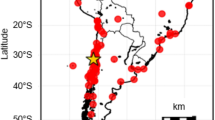Abstract
The main purpose of this paper is to introduce a Bayesian event tree model for eruption forecasting (BET_EF). The model represents a flexible tool to provide probabilities of any specific event which we are interested in, by merging all the relevant available information such as theoretical models, a priori beliefs, monitoring measures, and any kind of past data. BET_EF is based on a Bayesian procedure and it relies on the fuzzy approach to manage monitoring data. The method deals with short- and long-term forecasting; therefore, it can be useful in many practical aspects such as land use planning and volcanic emergencies. Finally, we provide the description of a free software package that provides a graphically supported computation of short- to long-term eruption forecasting, and a tutorial application for the recent MESIMEX exercise at Vesuvius.



Similar content being viewed by others
References
Aspinall WP, Woo G (1994) An impartial decision-making procedure using expert judgment to assess volcanic hazards. In: Accademia Nazionale dei Lincei/British Council International Symposium (ed) Large explosive eruptions. Rome, 24–25 May 1993, Atti dei Convegni Lincei 112:211–220
Aspinall WP, Woo G,Voight B, Baxter PJ (2003) Evidence-based volcanology: application to eruption crises. J Volcanol Geotherm Res 128:273–285
Fournier d’Albe EM (1979) Objectives of volcanic monitoring and prediction. J Geol Soc Lond 136:321–326
Gelman A, Carlin JB, Stern HS, Rubin DB (1995) Bayesian data analysis. CRC, Boca Raton, FL
Hill DP et al (2001) Response plan for volcano hazards in the Long Valley Caldera and Mono craters region California. USGS Bull 2185
Jaquet O, Connor C, Connor L (2006) Probabilistic methodology for long term assessment of volcanic hazards. International High-Level Radioactive Waste Management Conference, Las Vegas, Nevada, 30 April–4 May 2006
Kilburn CRJ (2003) Multiscale fracturing as a key to forecasting volcanic eruptions. J Volcanol Geotherm Res 125:271–289
Marzocchi W, Zaccarelli L (2006) A quantitative model for the time-size distribution of eruptions. J Geophys Res 111:B04204. DOI 10.1029/2005JB003709
Marzocchi W, Sandri L, Gasparini P, Newhall C, Boschi E (2004) Quantifying probabilities of volcanic events: the example of volcanic hazard at Mt. Vesuvius. J Geophys Res 109:B11201. DOI 10.1029/2004JB003155
Marzocchi W, Sandri L, Furlan C (2006a) A quantitative model for Volcanic Hazard Assessment. In: Mader HM, Coles SG, Connor CB, Connor LJ (eds) Statistics in volcanology. IAVCEI Publications, ISBN 978-1-86239-208-3, pp 31–37
Marzocchi W, Sandri L, Selva J (2006b) BET_VH: a probabilistic tool for long- and short-term volcanic hazard assessment. Cities on Volcanoes 4, Quito, Ecuador, 23–27 January 2006
Newhall CG (2003) “Restless” isn’t always dangerous and “quiet” isn’t always reassuring! Cities on volcanoes 3, Hilo, Hawaii, 14–18 July 2003
Newhall CG, Hoblitt RP (2002) Constructing event trees for volcanic crises. Bull Volcanol 64:3–20. DOI 10.1007/s004450100173
Newhall CG, Self S (1982) The volcanic explosivity index (VEI): an estimate of the explosive magnitude for historical eruptions. J Geophys Res 87:1231–1238
Ozawa S, Miyazaki S, Nishimura T, Murakami M, Kaidzu M, Imakiire T, Ji X (2004) Creep, dike intrusion, and magma chamber deflation model for the 2000 Miyake eruption and the Izu islands earthquakes. J Geophys Res 109:B02410. DOI 10.1029/2003JB00260
Popper KP (1959) The logic of scientific discovery. Hutchinson, London
Sandri L, Marzocchi W, Zaccarelli L (2004) A new perspective in identifying the precursory patterns of volcanic eruptions. Bull Volcanol 66:263–275. DOI 10.1007/s00445-003-0309-7
Smith JQ (1988) Decision analysis: a Bayesian approach. Chapman and Hall, London
Sparks RSJ (2003) Frontiers: forecasting volcanic eruptions. Earth Planet Sci Lett 210:1–15
Toffler A (1990) Powershift. Bantam, New York
UNESCO (1972) Report of consultative meeting of experts on statistical study of natural hazards and their consequences, Document SC/WS/500, UNESCO, Paris, pp 1–11
Voight B, Cornelius RR (1991) Prospects for eruption prediction in near real-time. Nature 350:695–698
Woo G (1999) The mathematics of natural catastrophes. Imperial College Press, London
Zadeh L (1965) Fuzzy sets. Inf Control 8:338–353
Acknowledgements
This work was funded by the Italian Dipartimento della Protezione Civile in the frame of the 2004–2006 Agreement with Istituto Nazionale de Geofisica e Vulcanologia-INGV.
Author information
Authors and Affiliations
Corresponding author
Additional information
Editorial responsibility: M. Ripepe
Electronic supplementary material
Below is the link to the electronic supplementary material.
Rights and permissions
About this article
Cite this article
Marzocchi, W., Sandri, L. & Selva, J. BET_EF: a probabilistic tool for long- and short-term eruption forecasting. Bull Volcanol 70, 623–632 (2008). https://doi.org/10.1007/s00445-007-0157-y
Received:
Accepted:
Published:
Issue Date:
DOI: https://doi.org/10.1007/s00445-007-0157-y




